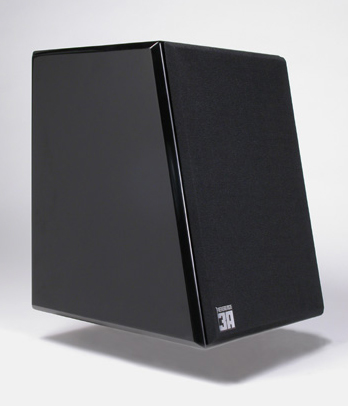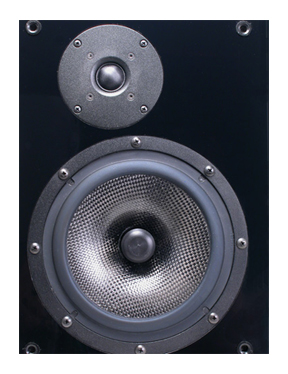You are reading the older HTML site
Positive Feedback ISSUE
17
january/february 2005
reference 3a
MM de Capo i loudspeakers
as reviewed by John Brazier and Ed Morawski

|
JOHN BRAZIER'S SYSTEM
LOUDSPEAKERS
ELECTRONICS
SOURCES
CABLES
|
 My
appreciation for fine woodworking has grown substantially over the years. It
is no coincidence that this appreciation has increased along with the growth
of my brother's carpentry business. What was once an "I'll build it if
you're gonna pay me for it" business has evolved into a refined operation
with 20,000 square feet of shop space and a medium to large fortune in
pieces of equipment that do very specific tasks. My brother is now a
sought-after New England Fine Cabinetmaker.
My
appreciation for fine woodworking has grown substantially over the years. It
is no coincidence that this appreciation has increased along with the growth
of my brother's carpentry business. What was once an "I'll build it if
you're gonna pay me for it" business has evolved into a refined operation
with 20,000 square feet of shop space and a medium to large fortune in
pieces of equipment that do very specific tasks. My brother is now a
sought-after New England Fine Cabinetmaker.
The Birdseye Maple version of the MM de Capo i loudspeakers currently occupying space in my living room have a fit and finish that reminds me of my brother's craftsmanship, even if the finish is a veneer. The half-inch chamfer surrounding the front of the speaker is neat and clean, and the same can be said of the corners. They look gorgeous, and this goes a long way in their spouse acceptance factor—mine gave them two thumbs up. Even with the grilles off, they have the presence of fine furniture.
 Like all Reference 3A speakers, the MM
de Capo
is a two-way, crossoverless design. I recently had the privilege to
reviewing the Reference 3A Dulcets, and found them to be near perfect in
every way, given their size. They will most certainly are my nomination for a
PFO Writers Choice Award for 2004. After reviewing and loving the Dulcets, I
requested a review pair of the 20-percent-larger MM de Capos, assuming that
they would maintain the sonic character of the Dulcets but be able to fill
my room better.
Like all Reference 3A speakers, the MM
de Capo
is a two-way, crossoverless design. I recently had the privilege to
reviewing the Reference 3A Dulcets, and found them to be near perfect in
every way, given their size. They will most certainly are my nomination for a
PFO Writers Choice Award for 2004. After reviewing and loving the Dulcets, I
requested a review pair of the 20-percent-larger MM de Capos, assuming that
they would maintain the sonic character of the Dulcets but be able to fill
my room better.
I placed the de Capos atop sand-filled, 26-inch Sound Organisation stands. The speaker cables were a fresh (but burned in) pair of Acoustic Zen Hologram IIs. The front end was the Naim 5i CDP player connected to the Brendensen IPO-80 integrated amp via a pair of Acoustic Zen Silver Reference II interconnects. A word on the speaker connections: The de Capos come ready for bi-wiring, with four very sturdy binding posts. This could cause connection frustration, but in a brilliant move, the folks at Reference 3A make the binding posts flush with the rear of the speakers (i.e., not in cups), then add tough Cardas jumpers. My single-wire connection was a snap. I cannot understand why this layout is not the norm.
I am not lucky enough to have a dedicated listening room—I listen in my living room. I therefore have all of the living-room-type demons that you'd expect: overstuffed furniture, coffee table, big TV between the speakers, etc. Setup can be a challenge. Real-world environment notwithstanding, I got the Dulcets to sound very very good. They faced straight out into the room, without any toe-in, so I sat the de Capos the same way. No go. After much experimentation, I found that they sounded best toed in about 10 percent. At less then 10 percent, they lost focus. At more, they became congested. Given the room constraints, they sat about ten feet apart and two feet away from the wall.
I decided to pull out some of my older reference recordings for some reason. These were the discs that I used to carry around with me when there was a chance of lounging around some newly discovered audio emporium. They are, in no particular order, Kruder Dorfmeister's The K&D Sessions, Stacy Kent's Love is… the tender trap, and Joan Osborne's Relish. They are not exactly "oldies," but all of them have long since been replaced in my cache of carry-around-just-in-case music.
 Once, in Kansas City, I heard the Stacy Kent CD
on a pair of ProAc 2.5s driven by some Audio Research gear. She sounded
wonderful, but the system hit it out of the park on track 11, "In The Wee
Small Hours Of The Morning." At no other time had her voice sounded so true
and honest. Had all the tracks sounded so incredible, I might have purchased
the system on the spot. I didn't, but I have never forgotten the purity of
that track on that day. I have been seeking a similar experience ever since,
on speakers that can tell the truth on all the tracks of that CD, not just
track 11.
Once, in Kansas City, I heard the Stacy Kent CD
on a pair of ProAc 2.5s driven by some Audio Research gear. She sounded
wonderful, but the system hit it out of the park on track 11, "In The Wee
Small Hours Of The Morning." At no other time had her voice sounded so true
and honest. Had all the tracks sounded so incredible, I might have purchased
the system on the spot. I didn't, but I have never forgotten the purity of
that track on that day. I have been seeking a similar experience ever since,
on speakers that can tell the truth on all the tracks of that CD, not just
track 11.
Enter the de Capos. Ms. Kent sounded so honest and pure that I sank into my seat in complete relaxation. Could I have found the Holy Grail? Maybe, but if not, this was the next best thing. Track 11 sounded brilliant, as did all the others. This CD is a collection of jazz standards, performed by a superb collection of musicians. On the de Capos, the music was layered, each instrument and Kent's voice perfectly integrated with the others. These speakers allowed each element of each track to be fully represented. They produced a clear, delineated, and complete musical message. Another wonderful track is "Comes Love." The de Capos made easy work of this tuneful, dynamic piece. At one point, the band takes over, and some members begin to scat sing as they jam. Even this relatively insignificant contribution to the piece came across in a pure and undisturbed manner. When Kent jumped back in, the de Capos had her in complete control, and gave her body—a hard thing for stand-mounted speakers to do. The de Capos have a full and rich midband, but it never becomes bloated.
At one time, Joan Osborne's 1995 debut disc, Relish, was in such high rotation at my home that I was concerned that I would wear it out. The de Capos worked magic on this disc. As with the Stacy Kent CD, her voice and each instrument came across in neat, clean, individual layers. The de Capos were seamless throughout their entire frequency range.
I played The K&D Sessions for its dynamics and bottom end. To do this disc justice, loudspeakers should provide massive air movement. Much to my delight, the de Capos low-end air movement was very good. The bass was also tuneful, with no bloat or boom. However, in the upper bass to lower midrange, there was slightly too much warmth—not enough to affect the overall character, but enough so that the sound on some tracks leaned toward the warm side of neutral.
Are the MM de Capos just bigger, more dynamic, versions of the Dulcets? That is a tough question. The de Capos hold their ground, as do the Dulcets. On some levels, the Dulcets are as good as stand-mounted speakers get, but ultimately, I tip my hat to the de Capos. They have all of the great qualities of the Dulcets, but do a better job of filling my room. It was a bit of a struggle to get them positioned, but it was worth it. Since moving into my current home, I have been almost exclusively reviewing headphone gear, and have been contemplating reacquiring a two-channel setup. I will contemplate no longer! My new system will be built around this beautiful Birdseye Maple pair of Reference 3A MM de Capos. Put them on your audition list, even if you are seeking floorstanders. John Brazier
|
ED MORAWSKI'S SYSTEM:
LOUDSPEAKERS
ELECTRONICS
SOURCES
CABLES
ACCESSORIES
|
 The
Reference 3A MM de Capo speakers caught my eye some time ago, so I was quite
anxious to audition them and do a review. I suppose that what interested me was
the slope of the cabinet face and the slightly odd dimensions (11 inches wide by
15 inches tall by 13 inches deep) necessitated by the rather large 8-inch bass
driver. Reference 3A indicates specs of 42Hz to 20kHz @ 3 B and a very
efficient 92dB sensitivity.
The
Reference 3A MM de Capo speakers caught my eye some time ago, so I was quite
anxious to audition them and do a review. I suppose that what interested me was
the slope of the cabinet face and the slightly odd dimensions (11 inches wide by
15 inches tall by 13 inches deep) necessitated by the rather large 8-inch bass
driver. Reference 3A indicates specs of 42Hz to 20kHz @ 3 B and a very
efficient 92dB sensitivity.
I initially set the speakers on 24-inch stands in the usual position in my room—about 7 feet apart, 18 inches from each side wall, and 24 inches from the rear wall. My first impression was of very high resolution with a fair amount of bass. Several people dropped by my home that day for a cookout, so while I was not able to listen critically, other people sampled the de Capos while I performed chef duties. To my surprise, the universal comment was, "Man, those new speakers are bright!" I didn't pay attention to this, but it stuck in my mind.
When I was able to return to the evaluation, I realized that everyone had been listening to one CD, The Coors Unplugged, because it was in my Musical Fidelity NuVista CD player and they were afraid to touch my equipment! This recording can sound bright, and when I listened to it with the MM de Capos, it sounded that way to me as well. I tried a few Alison Krauss albums, but did not enjoy the sound of those, either. The speakers were unfocused and lackluster. This really surprised me, so I tried another old favorite, Keiko Matsui's Deep Blue. Although I heard amazing detail and excellent high-end extension, the bass did not come along for the ride.
I tried repositioning the speakers. I listened to every type of music I had on hand—Celine Dion, Allison Krauss, Human, Norah Jones—but the result was the same. The de Capos had a good top end but a muddy, inconsistent bottom end. I attributed this to the large woofer and the rear port, which just did not work in my small (10 x 10-foot) room. The soundstage was nothing to write home about either, although vocals were quite good if you could overlook the brilliant highs and not-so-brilliant lows.
I felt that I still had not positioned these speakers to their benefit, so I spent an entire day trying every possible variation. Toeing them in a bit helped the focus. Raising them did no good, but lowering them began to help. Now I was getting somewhere! I tried objects of varying height under the speakers, but I still was not pleased. Finally I did the most radical thing ever, and placed them on the floor! They sounded much better. The bass was tamed, though still not tight enough, and while the brightness was also diminished, the imaging suffered.
I got out some 18 x 18-inch, one-inch-thick marble
tiles that I keep around for such purposes, and placed them between the speakers
and the floor. The bass was now the best so far, but the imaging still lacked
coherence. Rummaging through my tweak
 box, I found some very large spikes I had
made from some Home Depot plumb bobs. I placed two under the front of each
speaker, causing them to tilt back about 20 degrees. Now we're talking! The
imaging and focus snapped into place and the bass improved as well. The same CDs
went back into rotation, and all of them sounded good. One CD that really
impressed me was a total fluke, Life for Rent by Dido, a recording by one of
those British pop queens that I purchased trying to introduce myself to the
music of the younger generation. The indifferent engineering, combined with
purposely introduced snaps, pops, and static, had made the CD virtually unlistenable, but guess what? This time I almost enjoyed it! I listened to the
entire CD for the very first time, and while my opinion of the music didn't
change, I was struck by how much better it sounded.
box, I found some very large spikes I had
made from some Home Depot plumb bobs. I placed two under the front of each
speaker, causing them to tilt back about 20 degrees. Now we're talking! The
imaging and focus snapped into place and the bass improved as well. The same CDs
went back into rotation, and all of them sounded good. One CD that really
impressed me was a total fluke, Life for Rent by Dido, a recording by one of
those British pop queens that I purchased trying to introduce myself to the
music of the younger generation. The indifferent engineering, combined with
purposely introduced snaps, pops, and static, had made the CD virtually unlistenable, but guess what? This time I almost enjoyed it! I listened to the
entire CD for the very first time, and while my opinion of the music didn't
change, I was struck by how much better it sounded.
Some violin, courtesy of Lara St John and Ludwig von Beethoven, never sounded better. Loreena McKennitt's harp was crisp and clear, Diana Krall's piano sharp and very musical. The MM de Capos have great delicate extension and a rich midrange. They would be a perfect match for a low-powered SET amp. I doubt many of you will have the positioning problems I had, and I doubt Reference 3A will be amused at my unconventional placement, but that's why PFO tries to have equipment reviewed by different people with different equipment in different rooms.
I continued to listen over the next few weeks. At many points I relented and tried the de Capos on stands, but the muddy bass always returned. I tried several ways of coupling the speakers to the stands—Bluetack, silicon adhesive, doubleback tape, and nothing. The result was always the same. Hollow steel stands filled with sand or shot might do the trick, but I will have to leave that to another reviewer. I also tried the de Capos in a larger room, as the front speakers in my home theater setup. I did not notice any negatives—or positives—regarding the bass, but this is hardly fair. I don't listen to music on this system because of the odd room dimensions and acoustics. (One end is completely open to the rest of the house.)
Your experience may be different than mine. My listening room is one of the toughest acoustic environments for speakers, and many acclaimed speakers have failed to meet its challenge. If you take the time, the de Capos will be competent when the correct placement is worked out. Ed Morawski
de Capo i loudspeakers
Retail: $2500/pair
Reference 3A
web address: www.reference3a.com
Divergent Technologies
web address: www.divertech.com
